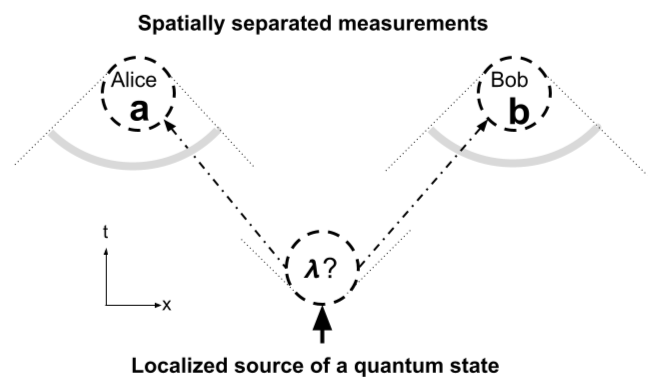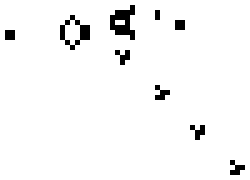|
Counterfactual Definiteness
In quantum mechanics, counterfactual definiteness (CFD) is the ability to speak "meaningfully" of the definiteness of the results of measurements that have not been performed (i.e., the ability to assume the existence of objects, and properties of objects, even when they have not been measured). The term " counterfactual definiteness" is used in discussions of physics calculations, especially those related to the phenomenon called quantum entanglement and those related to the Bell inequalities. In such discussions "meaningfully" means the ability to treat these unmeasured results on an equal footing with measured results in statistical calculations. It is this (sometimes assumed but unstated) aspect of counterfactual definiteness that is of direct relevance to physics and mathematical models of physical systems and not philosophical concerns regarding the meaning of unmeasured results. Overview The subject of counterfactual definiteness receives attention in the study of quantum ... [...More Info...] [...Related Items...] OR: [Wikipedia] [Google] [Baidu] |
Quantum Mechanics
Quantum mechanics is the fundamental physical Scientific theory, theory that describes the behavior of matter and of light; its unusual characteristics typically occur at and below the scale of atoms. Reprinted, Addison-Wesley, 1989, It is the foundation of all quantum physics, which includes quantum chemistry, quantum field theory, quantum technology, and quantum information science. Quantum mechanics can describe many systems that classical physics cannot. Classical physics can describe many aspects of nature at an ordinary (macroscopic and Microscopic scale, (optical) microscopic) scale, but is not sufficient for describing them at very small submicroscopic (atomic and subatomic) scales. Classical mechanics can be derived from quantum mechanics as an approximation that is valid at ordinary scales. Quantum systems have Bound state, bound states that are Quantization (physics), quantized to Discrete mathematics, discrete values of energy, momentum, angular momentum, and ot ... [...More Info...] [...Related Items...] OR: [Wikipedia] [Google] [Baidu] |
Locality Principle
In physics, the principle of locality states that an object is influenced directly only by its immediate surroundings. A theory that includes the principle of locality is said to be a "local theory". This is an alternative to the concept of instantaneous, or "non-local" action at a distance. Locality evolved out of the field theories of classical physics. The idea is that for a cause at one point to have an effect at another point, something in the space between those points must mediate the action. To exert an influence, something, such as a wave or particle, must travel through the space between the two points, carrying the influence. The special theory of relativity limits the maximum speed at which causal influence can travel to the speed of light, c. Therefore, the principle of locality implies that an event at one point cannot cause a truly simultaneous result at another point. An event at point A cannot cause a result at point B in a time less than T=D/c, where D is the ... [...More Info...] [...Related Items...] OR: [Wikipedia] [Google] [Baidu] |
Quantum Indeterminacy
Quantum indeterminacy is the apparent ''necessary'' incompleteness in the description of a physical system, that has become one of the characteristics of the standard description of quantum physics. Prior to quantum physics, it was thought that Quantum indeterminacy can be quantitatively characterized by a probability distribution on the set of outcomes of measurements of an observable. The distribution is uniquely determined by the system state, and moreover quantum mechanics provides a recipe for calculating this probability distribution. Indeterminacy in measurement was not an innovation of quantum mechanics, since it had been established early on by experimentalists that errors in measurement may lead to indeterminate outcomes. By the later half of the 18th century, measurement errors were well understood, and it was known that they could either be reduced by better equipment or accounted for by statistical error models. In quantum mechanics, however, indeterminacy is of a ... [...More Info...] [...Related Items...] OR: [Wikipedia] [Google] [Baidu] |
Naïve Realism
In philosophy of perception and epistemology, naïve realism (also known as direct realism, manifest realism or perceptual realism) is the idea that the senses provide us with direct awareness of objects as they really are. When referred to as direct realism, naïve realism is often contrasted with indirect realism. According to the naïve realist, the objects of perception are not representations of external objects, but are in fact those external objects themselves. The naïve realist is typically also a metaphysical realist, holding that these objects continue to obey the laws of physics and retain all of their properties regardless of whether or not there is anyone to observe them.Naïve Realism ''Theory of Knowledge.com''. They are composed of |
Interaction-free Measurement
In physics, interaction-free measurement is a type of measurement in quantum mechanics that detects the position, presence, or state of an object without an interaction occurring between it and the measuring device. Examples include the Renninger negative-result experiment, the Elitzur–Vaidman bomb-testing problem, and certain double-cavity optical systems, such as Hardy's paradox. In quantum computation such measurements are referred to as counterfactual quantum computation, an idea introduced by physicists Graeme Mitchinson and Richard Jozsa. Examples include Keith Bowden's Counterfactual Mirror Array,Bowden, Keith G, "Classical Computation can be Counterfactual", in Aspects I, Proc ANPA19, Cambridge 1997 (published May 1999), describing a digital computer that could be counterfactually interrogated to calculate whether a light beam would fail to pass through a maze. Initially proposed as thought experiments by R. H. Dicke in 1981 , interaction-free measurements have been exp ... [...More Info...] [...Related Items...] OR: [Wikipedia] [Google] [Baidu] |
Determinism
Determinism is the Metaphysics, metaphysical view that all events within the universe (or multiverse) can occur only in one possible way. Deterministic theories throughout the history of philosophy have developed from diverse and sometimes overlapping motives and considerations. Like Eternalism (philosophy of time), eternalism, determinism focuses on particular events rather than the future as a concept. Determinism is often contrasted with free will, although some philosophers claim that the two are compatibilism, compatible. A more extreme antonym of determinism is indeterminism, or the view that events are not deterministically caused but rather occur due to random chance. Historically, debates about determinism have involved many philosophical positions and given rise to multiple varieties or interpretations of determinism. One topic of debate concerns the scope of determined systems. Some philosophers have maintained that the entire universe is a single determinate system ... [...More Info...] [...Related Items...] OR: [Wikipedia] [Google] [Baidu] |
Robert Griffiths (physicist)
Robert B. Griffiths (February 25, 1937) is an American physicist at Carnegie Mellon University. He is the originator of the consistent histories approach to quantum mechanics, which has since been developed by himself, Roland Omnès, Murray Gell-Mann, and James Hartle James Burkett Hartle (August 17, 1939 – May 17, 2023) was an American theoretical physicist. He joined the faculty of the University of California, Santa Barbara in 1966, and was a member of the external faculty of the Santa Fe Institute. Hart .... References External links Consistent Histories: Questions and Answers {{DEFAULTSORT:Griffiths, Robert Living people 1937 births Members of the United States National Academy of Sciences Carnegie Mellon University faculty American Christians American people of Welsh descent American mathematical physicists 20th-century American physicists 21st-century American physicists ... [...More Info...] [...Related Items...] OR: [Wikipedia] [Google] [Baidu] |
Consistent Histories
In quantum mechanics, the consistent histories or simply "consistent quantum theory" interpretation generalizes the complementarity aspect of the conventional Copenhagen interpretation. The approach is sometimes called decoherent histories and in other work decoherent histories are more specialized. First proposed by Robert Griffiths in 1984, this interpretation of quantum mechanics is based on a consistency criterion that then allows probabilities to be assigned to various alternative histories of a system such that the probabilities for each history obey the rules of classical probability while being consistent with the Schrödinger equation. In contrast to some interpretations of quantum mechanics, the framework does not include "wavefunction collapse" as a relevant description of any physical process, and emphasizes that measurement theory is not a fundamental ingredient of quantum mechanics. Consistent histories allows predictions related to the state of the universe ne ... [...More Info...] [...Related Items...] OR: [Wikipedia] [Google] [Baidu] |
Umass Amherst
The University of Massachusetts Amherst (UMass Amherst) is a public land-grant research university in Amherst, Massachusetts, United States. It is the flagship campus of the University of Massachusetts system and was founded in 1863 as the Massachusetts Agricultural College. It is also a member of the Five College Consortium, along with four other colleges in the Pioneer Valley. UMass Amherst has the largest undergraduate population in Massachusetts with roughly 24,000 enrolled undergraduates. The university offers academic degrees in 109 undergraduate, 77 master's, and 48 doctoral programs in nine schools and colleges. It is classified among "R1: Doctoral Universities – Very high research activity". According to the National Science Foundation, the university spent $211 million on research and development in 2018. The university's 21 varsity athletic teams compete in NCAA Division I and are collectively known as the Minutemen and Minutewomen. The university is a member o ... [...More Info...] [...Related Items...] OR: [Wikipedia] [Google] [Baidu] |
Many-worlds Interpretation
The many-worlds interpretation (MWI) is an interpretation of quantum mechanics that asserts that the universal wavefunction is Philosophical realism, objectively real, and that there is no wave function collapse. This implies that all Possible world, possible outcomes of quantum measurements are physically realized in different "worlds". The evolution of reality as a whole in MWI is rigidly Determinism, deterministic and principle of locality, local. Many-worlds is also called the relative state formulation or the Everett interpretation, after physicist Hugh Everett III, Hugh Everett, who first proposed it in 1957.Hugh Everett]Theory of the Universal Wavefunction Thesis, Princeton University, (1956, 1973), pp. 1–140. Bryce DeWitt popularized the formulation and named it ''many-worlds'' in the 1970s. See also Cécile DeWitt-Morette, Cecile M. DeWitt, John A. Wheeler (eds,) The Everett–Wheeler Interpretation of Quantum Mechanics, ''Battelle Rencontres: 1967 Lectures in Mathema ... [...More Info...] [...Related Items...] OR: [Wikipedia] [Google] [Baidu] |
Asher Peres
Asher Peres (; January 30, 1934 – January 1, 2005) was an Israeli physicist. Peres is best known for his work relating quantum mechanics and information theory. He helped to develop the Peres–Horodecki criterion for quantum entanglement, as well as the concept of quantum teleportation, and collaborated with others on quantum information and special relativity. He also introduced the Peres metric and researched the Hamilton–Jacobi–Einstein equation in general relativity. With Mario Feingold, he published work in quantum chaos that is known to mathematicians as the Feingold–Peres conjecture and to physicists as the Feingold–Peres theory. Life According to his autobiography, he was born ''Aristide Pressman'' in Beaulieu-sur-Dordogne in France, where his father, a Polish electrical engineer, had found work laying down power lines. He was given the name ''Aristide'' at birth, because the name his parents wanted, ''Asher'', the name of his maternal grandfather, w ... [...More Info...] [...Related Items...] OR: [Wikipedia] [Google] [Baidu] |




